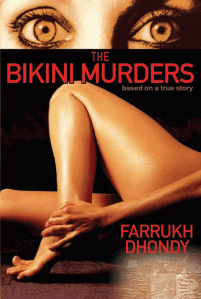Killer and creator
Fact and fiction interbleed unnervingly in this novel loosely based on Charles Sobhraj’s life
 The Bikini Murders
The Bikini Murders
Farrukh Dhondy
HarperCollins India
vi + 272
There are three threads to this novel. If you want to be entertained, you can make do with the first. But to be properly discomfited, you need to know about the other two.
Thread 1 is the story of Johnson Thhat, Vietnamese-Indian-French thief, trickster and murderer. He’s the protagonist. Thread 2 is the life and career of Charles Sobhraj, the Vietnamese-Indian-French alleged thief, trickster and murderer. He is the real-life occasion for Thhat. Thread 3 is that part of author Farrukh Dhondy’s own life that intersects with Sobhraj’s, with a few extra personal odds and ends thrown in.
Like Sobhraj, Thhat is born to a Vietnamese mother and an Indian father in Saigon. From there on, biographically speaking, Thhat’s story echoes Sobhraj’s in several of the major (alleged) details. He moves to France, gets into petty crime, spends time in jail, escapes to Bombay and thence onward to Bangkok, where his career as serial murderer gets underway. In India, Thhat’s father entrusts him to Ravina, who goes with him to Thailand, teaches him the illegal gems trade and how to poison people, and eventually becomes his lover. It’s not quite Sobhraj, but there are certainly echoes of his real-life early 1970s pan-Asian crime spree in the company of his upper-class French wife and accomplice Chantal.
That’s one small example of the three threads meeting: Thhat’s Ravina is also from the upper classes, a general’s daughter. And Dhondy in his youth eloped to England with Mala Sen, a general’s daughter.
Another is the curious case of Sobhraj’s memoir. In 2002 Dhondy, then a BBC4 producer in London, was approached by Sobhraj, then free and living in Paris. Sobhraj wanted Dhondy’s help in selling his memoirs. Dhondy found an agent, but neither of them thought the manuscript worth publishing. Today Dhondy says it was full of “boasts” about how he, Sobhraj, had ruled Tihar Jail, and so on, instead of the infinitely more marketable “confessions” of a serial killer. Sobhraj has returned the favour, calling Dhondy, in effect, a hanger-on and profiteer.
Later Dhondy tried doing a TV programme on Sobhraj, but that too fell through, for lack of cooperation from the subject.
“I wrote something else before, my story,” Dhondy has Thhat tell Nepali inspector Ganesh Pradhan on page 21, “but from a different angle — all lies actually. I tried to sell it, but it was rejected. I know something now — if I tell the truth it will be understood better than any story I can make up… It was boastful, you know, bragging.”
Pradhan is the officer who arrests Thhat in a Kathmandu casino (as Sobhraj was in 2003). He’s the archetypal middle-aged loner detective, dogged, independent-minded and fundamentally decent, but ultimately at his superiors’ disposal; thus he is a good foil to Thhat, who is guiltlessly amoral but always controlled by his razor-sharp brain; both, from long experience, have a very good understanding of people and their flaws.
Knowing that Pradhan cannot be charmed, yet has the true detective’s obsessive (and flattering) need to know, Thhat respects Pradhan enough to offer to write him his true confessions, if he will later mail them to his publishing contact in London (a writer named Murad Sultani, in some ways a stand-in for Dhondy). Pradhan agrees, while telling himself that “It was the paranoid importance of the delusional criminal.” But his fascination is too powerful.
It is this confessional/memoir around which Dhondy’s novel is built, and in which Thhat offers a view of the individuals who impinged upon his life (not all of whom have real-life equivalents). The part-players are few but well realised: Ravina, ravishing, vicious and vulnerable; Chandrika Nath, the diamond-hard RAW agent; Virginie, who is not virginal; Murad Sultani, the author who wants Thhat’s story; and Thhat’s father Janimal, a beast who ascends from the underworld like a diabolus ex machina to save his son, more than once.
There’s a host of lesser figures, and — the plot takes a bizarre turn into spy thriller territory — shadowy CIA types, Afghans, Arabs, Pakistanis, Russians, Chinese triads… Even Ravina and Thhat’s victims are well-observed, with the picture skilfully flattened to reflect Thhat’s contempt for their fallibility.
The Bikini Murders is so well written that it’s just this side of literary. It’s because the author’s hand is obviously masterful that the whole becomes so disturbing: there’s no real boundary between fact and fiction. Instead, the deliberate interbleeding of life and art produces a potent and vivifying undercurrent of irony — and it is this that, finally, saves the book from being a literary shafting.

leave a comment